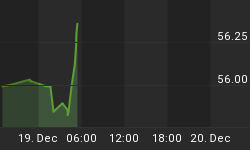Warnings of multi-year trend turns can be gleaned from the NYSE New Highs data when we take a 10 day average and plot it against the Dow Jones Industrial Average. What we are looking for are multiyear divergences between New High Peaks and equity index prices. On the chart below, we plotted the 10 day average for New 52 Week Highs since June 1999 versus the price action of the Dow Industrials. During the Bear Market of 2000 through 2002 New Highs diverged Bullishly against the Price of the Dow Industrials. When the divergence ended in May 2003, it acted as a "buy" confirmation that a multi-year advance was underway. The length of the divergence gave us a clue as to the length of the developing rally - it would be multi-year.

Since January 2004, the 10 day Average NYSE New Highs trend-line has declined steadily, diverging Bearishly with Prices. This has been going on for two years. Thus we are once again faced with a warning of an approaching major multi-month, perhaps multi-year trend change - this time down. Confirmation will arrive when both New High Peaks and Prices decline in unison. The parallel decline may only last a few months before the start of the next Bullish divergence, however the trend down in prices should continue long afterwards, a key component in the next Bullish divergence (prices decline as New High peaks rise).
The next chart shows an historic precedent for what we see developing now, a similar Bearish divergence. From July 1997 through January 2000, the Dow Industrials Price rose while the 120 day average NYSE New 52 Week Highs Peaks declined. This multi-year divergence led to the massive Bear market in equities from 2000 through 2002. With a similar multi-year Bearish Divergence mature as of February 2006, this pattern is a serious shot over the bow.
If this doesn't grab you, then maybe the next three charts will. The price pattern in the Dow Industrials during late 2005 and early 2006 has formed a fractal, a near exact replica in miniature, of the topping pattern from 1999 through early 2000. It is astonishing, really. Prices descended into an autumn bottom (blue arrows), then rallied hard through the holidays, in near-parabolic ascents (red arrows). Then a five-point broadening top followed (green). Point 6's tops each failed to exceed the point 4 tops, and in both instances prices dropped into a shallow point 7 bottom. So far an exact replica. If this pattern continues in 2006 as it did in 2000, then prices should soon drift higher into a point 8 top that fails to exceed point 6. What happened next in 2000? A 2 1/2 year 4,551 point, 38.7 percent plunge in the Dow Industrials. Wham. Pow. Crash. Bang. Smasharoo.




If you would like a Free 30 day Trial Subscription to check out our remarkable buy/sell signals on the blue chip Dow Industrials and S&P 500, NASDAQ 100, or HUI Amex Gold Bugs Index, simply go to www.technicalindicatorindex.com, and click on the "Contact Us" button, and email us with your request, including a password you would prefer to use to access our site. A subscription gains you access to index buy/sell signals, our thrice weekly Market Analysis Newsletters, Traders Corner, Guest Articles, and our Archives. On October 13th, 2005 we closed out our latest Trader's Corner transaction with a 51.8 percent profit over a 21 trading day period (this is not an annualized figure). The prior trade garnered a 34 percent profit.
"Not that we are adequate in ourselves to consider
anything as coming from ourselves, but our adequacy is from God."
I Corinthians 3:5
















